
The ruddy turnstone is a small wading bird, one of two species of turnstone in the genus Arenaria. The scientific name is from Latin. The genus name arenaria derives from arenarius, "inhabiting sand, from arena, "sand". The specific interpres means "messenger"; when visiting Gotland in 1741, Linnaeus thought that the Swedish word Tolk "interpreter" applied to this species, but in the local dialect the word means "legs" and is used for the redshank.

Ctenizidae is a small family of medium-sized mygalomorph spiders that construct burrows with a cork-like trapdoor made of soil, vegetation and silk. They may be called trapdoor spiders, as are similar species, such as those of the families Liphistiidae, Barychelidae, Cyrtaucheniidae and some species in Idiopidae and Nemesiidae. In 2018, the family Halonoproctidae was split off from Ctenizidae, leaving only three genera.

The Pholcidae are a family of araneomorph spiders. The family contains over 1,800 pholcids, including those commonly known as the marbled cellar spider , daddy long-legs spider, granddaddy long-legs spider, carpenter spider, daddy long-legger, vibrating spider, gyrating spider, long daddy, and skull spider. The family, first described by Carl Ludwig Koch in 1850, is divided into 94 genera.

The sac spiders of the family Clubionidae have a very confusing taxonomic history. Once, this family was a large catch-all taxon for a disparate collection of spiders, similar only in that they had eight eyes arranged in two rows and conical anterior spinnerets that touched, and were wandering predators that built silken retreats, or sacs, usually on plant terminals, between leaves, under bark, or under rocks. These are now recognized to include several families, some of which are more closely related to the three-clawed spiders, like lynx and wolf spiders, than to Clubionidae and related families.

Hexathelidae is a family of mygalomorph spiders. It is one of a number of families and genera of spiders known as funnel-web spiders. In 2018, the family was substantially reduced in size by genera being moved to three separate families: Atracidae, Macrothelidae and Porrhothelidae. Atracidae includes the most venomous species formerly placed in Hexathelidae.

The Texas antelope squirrel is a species of rodent in the family Sciuridae. It is found in Mexico and in both Texas and New Mexico within the United States.
Ceratinopsis monticola, is a species of spider of the genus Ceratinopsis. It is endemic to Sri Lanka.
Ceratinopsidis is a monotypic genus of North American dwarf spiders containing the single species, Ceratinopsidis formosa. It was first described by S. C. Bishop & C. R. Crosby in 1930, and has only been found in United States.
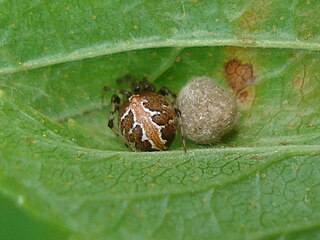
Theridion pictum is a species of cobweb spider in the family Theridiidae. It is found in the United States, Canada, Europe, and Turkey. It is the type species of the genus Theridion.
Ceratinopsis nigriceps is a species of dwarf spider in the family Linyphiidae. It is found in the United States and Canada.
Urozelotes rusticus is a species of ground spider found in both Americas, Africa, Europe, Asia, Australia. Its native area is unknown, but it is most likely Old World.
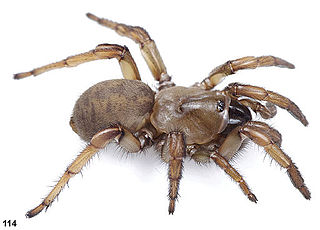
Aptostichus stanfordianus, the Stanford Hills trapdoor spider, is a species of wafer-lid trapdoor spider (Euctenizidae) endemic to California in the United States.
Ceratinopsis labradorensis is a species of dwarf spider in the family Linyphiidae. It is found in Canada.

Agelenopsis emertoni is a species of funnel weaver in the family of spiders known as Agelenidae. It is found in the United States. The spider was named to honour arachnologist James H. Emerton. A. emertoni is distinguished from other Agelenopsis species in the genus by the male's loosely coiling embolus making more than one full circle, and a claw-like conductor tip. These features are sclerites of the male sex organ which is used to inseminate the female. The female has a distinctive conducting tube in her genitalia. The male can be between 6 and 13mm. Distribution is in the following states of the USA: Arkansas, Colorado, Florida, Georgia, Louisiana, Massachusetts, Mississippi, Missouri, New Jersey, New York, North Carolina, Oklahoma, Pennsylvania, Tennessee, Texas, Virginia.
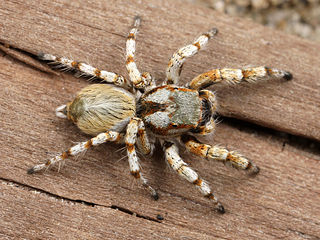
Habronattus amicus is a species of jumping spider in the family Salticidae. It is found in the United States.

Mecaphesa asperata, the northern crab spider, is a species of crab spider in the family Thomisidae, found in North and Central America, and the Caribbean. It is a species of the 'flower spiders', so-called because they generally hunt in similarly coloured flowers for visitors such as bees and flies, and is a much smaller nearctic relative of the better-known Goldenrod Spider.
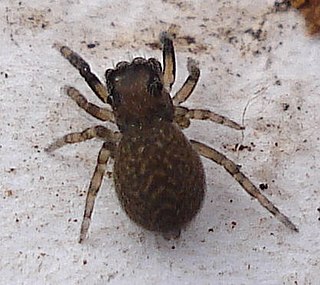
Neon reticulatus is a species of jumping spider in the family Salticidae. It is found in North America, Europe, Turkey, Caucasus, a range from Russia (European to the Far East, Kazakhstan, Korea, and Japan.

Hyptiotes cavatus, the triangle weaver, is a species of cribellate orb weaver in the family of spiders known as Uloboridae. It is found in the United States and Canada. It uses an unusual hunting technique whereby it tightens up an anchor line of the web whilst waiting for prey. This effectively winds up and compresses the web. When prey touches the web, the spider releases the held anchor line, causing the web to spring forwards 2-3cm at high speed. This causes up to 4 additional web strands to touch the prey, and the sudden stop when the web reaches the end of its elasticity then winds the prey further into the strands. This process has analogues to the techniques by humans used to power catapults and ballistae.
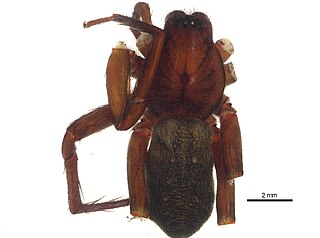
Anachemmis linsdalei is a species of false wolf spiders & wandering spiders in the family Zoropsidae. It is found in the United States and Mexico.
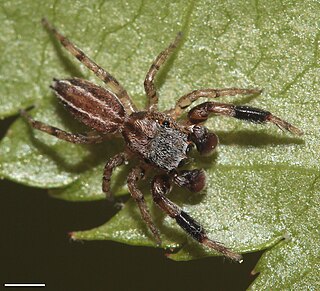
Marpissa lineata is a species of jumping spider in the family Salticidae. It is found in the United States.














